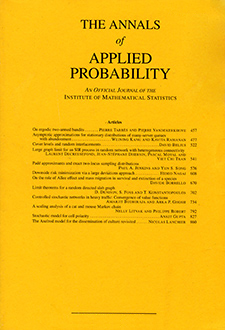Abstract
Randomized load balancing networks arise in a variety of applications, and allow for efficient sharing of resources, while being relatively easy to implement. We consider a network of parallel queues in which incoming jobs with independent and identically distributed service times are assigned to the shortest queue among a subset of $d$ queues chosen uniformly at random, and leave the network on completion of service. Prior work on dynamical properties of this model has focused on the case of exponential service distributions. In this work, we analyze the more realistic case of general service distributions. We first introduce a novel particle representation of the state of the network, and characterize the state dynamics via a countable sequence of interacting stochastic measure-valued evolution equations. Under mild assumptions, we show that the sequence of scaled state processes converges, as the number of servers goes to infinity, to a hydrodynamic limit that is characterized as the unique solution to a countable system of coupled deterministic measure-valued equations. As a simple corollary, we also establish a propagation of chaos result that shows that finite collections of queues are asymptotically independent. The general framework developed here is potentially useful for analyzing a larger class of models arising in diverse fields including biology and materials science.
Citation
Reza Aghajani. Kavita Ramanan. "The hydrodynamic limit of a randomized load balancing network." Ann. Appl. Probab. 29 (4) 2114 - 2174, August 2019. https://doi.org/10.1214/18-AAP1444
Information





